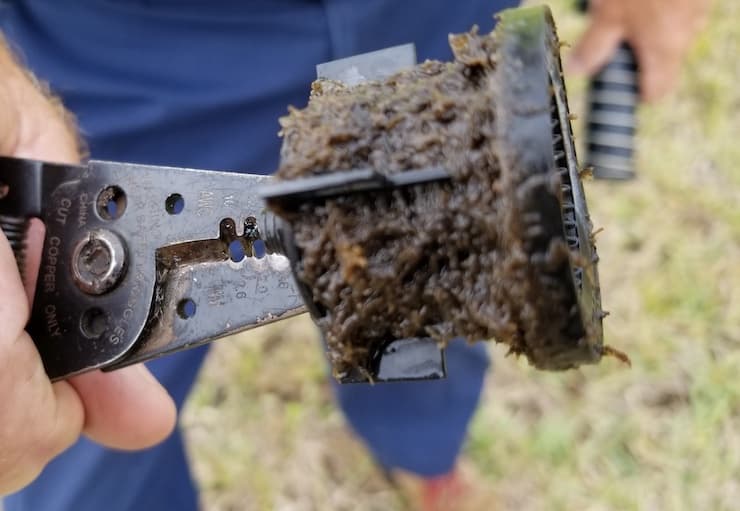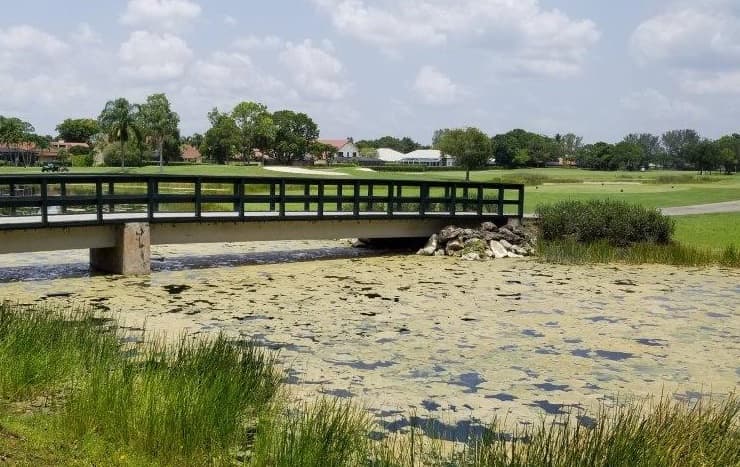
We’ve written previously about the importance of maintaining a healthy irrigation lake, and the impact that adverse water quality can have on everything from the condition of your irrigation equipment to the state of the landscape being irrigated. In this article we’ll take an overview of the situation, looking at what you can do to maintain the best possible water quality in your irrigation lake, and some steps that can be taken in mitigation if the water quality is less than optimal.
This issue is a particular problem for anyone working with a lake-based irrigation system in Florida. A study carried out by the Environmental Integrity Project in March 2022 found that Florida has more polluted lakes than anywhere else in the US, while more recently it was reported that the area of the lakes across Florida identified as unsuitable for swimming and aquatic life had risen to 2.1 million acres in 2022, having been more than a million acres in 2018 but just 893,000 acres in 2020.
One issue that often leads to irrigation lakes – either man-made or natural – containing water which is of less than optimal quality is that people tend to assume that a body of water of this type and size – complete with wildlife and vegetation – maintains itself through a process of natural regulation.
The truth, however, is that any irrigation lake needs to be subject to regular maintenance tailored to deal with the kind of conditions and contamination which can all too easily diminish the quality of water being used for irrigation. At the same time, good maintenance ensures the aesthetic of the lake and its surroundings is maintained, especially when it’s serving a housing development, commercial property or golf course for example.
In simple terms the maintenance of the lake can be broken down into factors such as the aeration of the water, the removal of physical debris from the water and the upkeep of the shoreline of the lake, since the latter can play a huge role in helping to prevent contamination of the water through things like excessive storm water runoff. If storm water is able to run off into an irrigation lake unchecked and unimpeded it could raise the levels of unwanted chemicals and nutrients in the water, which in turn can exacerbate the appearance and growth of invasive species of plants and pests.
Ideally, the water in an irrigation lake should ‘turn over’ once every 24 hours, which means that the water at the top and bottom of the lake exchange places. Movement of this kind introduces higher levels of oxygen into the water, which supports the presence of wildlife and microbes which help to balance the quality of the water. Well balanced water which has been sufficiently oxygenated is less likely to provide a breeding ground for issues such as algae and aquatic weeds, as well as making it more difficult for debris to build up. Aeration of this kind can be achieved through the application of tools such as floating fountains and aerators. A floating fountain is exactly as the name suggests, a water feature on the surface of the irrigation lake which, as well as being aesthetically pleasing, helps to transfer the water and circulate oxygen near the surface. Fountains of this kind or surface aerators are the ideal solution for lakes which have an average depth of less than 4ft-6ft.
For deeper lakes a submersed aerator may be required. This device is fed by a pump on the side of the lake and releases bubbles from the bed of the lake. As these bubbles rise through the water they carry the low-oxygen water up to the surface where it is re-oxygenated before sinking back down again. Ongoing mixing of this kind will help to increase the amount of oxygen present in the whole of the irrigation lake. If the issue of powering the electrical pump which runs the aerator is difficult due to the location of the irrigation lake, then a solar-powered aerator could provide an alternative.
The best way to think of the shoreline of an irrigation lake is as a wall or border around the water. If that border becomes subject to natural erosion (something that can be caused by bad weather, recreational use or poor initial design) then it could lead to the loss of natural vegetation, excess runoff of the water in the lake and greater ingress of nutrients. All of these can combine to reduce the depth, quantity and quality of the water in the irrigation lake, as well as impacting negatively on its appearance.

An eroded shoreline also makes it more likely that heavy rainfall could see run-off carrying foreign bodies such as fertilizers, weed killers, animal waste, twigs and leaves into the water. Maintaining a healthy shoreline for your irrigation lake means prevention and cure in equal measure, using similar techniques to prevent the shoreline eroding in the first place and to protect and repair it when erosion has already taken place. A buffer zone can be planted 3-6 feet back from the shoreline itself to ensure that any run-off is absorbed before it reaches the lake.
Dense turf along this buffer zone can be made up of native grasses, which will also encourage local wildlife and possibly help to reduce the presence of mosquitoes. In some cases the erosion that has already taken place will mean that it isn’t possible to plant directly into the soil. In these cases mesh products can be put down to hold the soil in place and make it suitable for planting purposes, and in some cases biodegradable logs made of substances such as natural coconut fibers are put in place. These logs can support the shoreline, protect against moving water and waves and encourage deep-rooted plant growth.
If an irrigation lake has been neglected for some time, and particularly if no proactive steps have been taken, it’s likely that layers of sediment will have built up along the bottom. Sediment of this kind reduces the depth of the lake and encourages the presence of invasive plants and potentially toxic algae. Once allowed to build up to such a degree, sediment has to be removed by more drastic measures - through mechanical raking or dredging. Mechanical raking involves a floating barge pulling a hydro-rake through the water. It can be used at depths ranging from 1 foot to 10 feet and can also be applied to the removal of specifically targeted aquatic plants. A more expensive and extreme option for those lakes which are being greatly impacted by excess sediment – to such a degree that other water management methods are proving ineffectual – is hydraulic or mechanical dredging. This removes nutrient heavy, polluted soil, sand and other debris from the bottom of the lake and deals with it as contaminated material. Once the sediment has been removed, the water in the lake can be replenished and brought back up to standard.
Some plant life is to be welcomed in an irrigation lake, in terms of aesthetics and helping to maintain a healthy balance of nutrients and the ecosystem of the lake, but invasive algae and aquatic weeds and other micro-organisms like bryozoans can have a hugely detrimental impact.

At its worst, as recently happened to Lake Okeechobee, the largest freshwater lake in Florida, the issue of algae can become so severe that an entire body of water is infested with toxic slime. But in a smaller scale environment, the damage is just as catastrophic.

We reported on the impact of such toxic algae in the July 2023 edition of the H2O Zone, and it’s often triggered by the kind of run-off that can be prevented by the shoreline remediation measures outlined above. Also key to preventing aquatic weeds and algae becoming established in an irrigation lake is a maintenance program that includes monitoring the plant-life in the lake. Of course, this must be carried out by experts in the field who will be able to differentiate between native plant life - which is welcome - and invasive species which is not!
There are several non-native plants likely to be found in lakes and water ways which have been classified as ‘invasive’ by the University of Florida. Listed here in alphabetical order, they are:
Although each of these invasive species has its own characteristics and threat profile, common problems caused when an invasive species becomes established within an irrigation lake include the destruction of the natural habitat, changes to the pH levels in the water and depletion of the oxygen present and an acceleration in the buildup of sediment.
Regular monitoring will enable the presence of invasive plants to be spotted at an early stage, and the correct control methods applied. For larger areas of plant life – particularly those which form a thick canopy on the surface of the water - these control methods might include mechanical clearing using harvesting equipment. This equipment, operated by specialists, will cut the weeds and carry them on board the unit via a conveyor belt. Once ashore, the plant life can be left to dry out and then taken away to be disposed of. In other cases, the removal may need to be more targeted, in which case herbicides may need to be applied.
It hardly needs stating that the application of herbicides in irrigation lakes needs to be carried by qualified and trained experts, and to involve only the use of herbicides which have been approved and registered by the Environmental Protection Agency (EPA).
Keeping your water source healthy is of primary importance when it comes to irrigation because any kind of contamination can cause untold damage - especially when, as in many cases, it’s left untreated. Irrigation management technologies that make it easy to keep a constant eye on your pump system coupled with an excellent maintenance program are a powerful combination - and essential tools in the drive to slash water and utility bills, minimize repair budgets and meet increasingly stringent water use budgets.